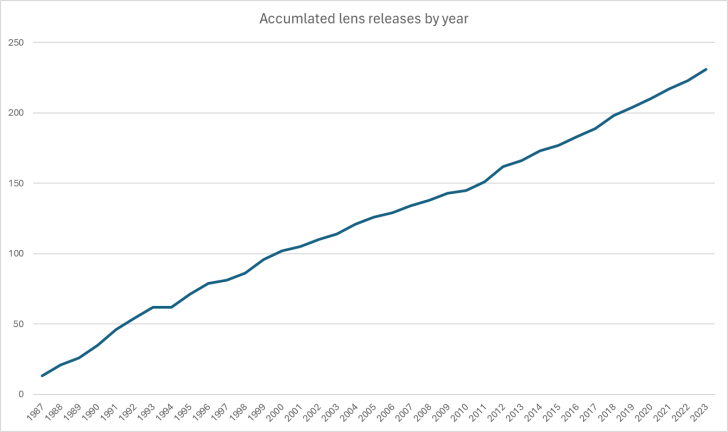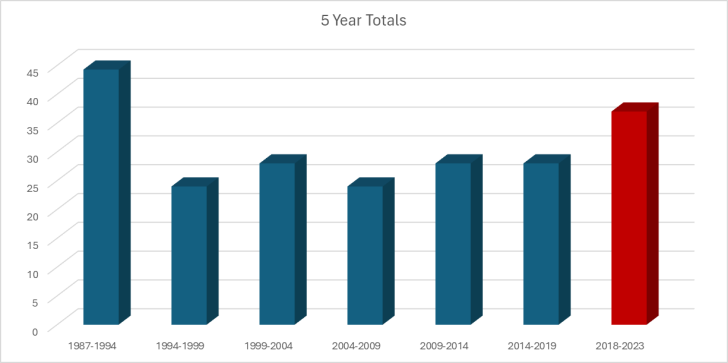
Part of me was thinking to myself that Canon’s lens releases have been very sluggish, or at least they just “felt” that way. So I decided to take a look at just how Canon did in their history from the EF mount onwards. So armed with Excel and Canon Camera Museum (honestly, if you haven’t spent a few hours there yet, you really need to do so), I went to work.
Having grabbed all the data I plotted out just how many lenses Canon has developed over the years (231 so far), and wanted to see if the rate looked dramatically lower during the RF years.


To my surprise, the plot really wasn’t that different. In actuality – Canon has averaged around 7 lenses over the RF mount timeframe (37 total lenses), whereas the overall average for the EF mount was around 6 lenses per year (194 total lenses).
Next, I wanted to see how Canon did during the 5 year segments, and how that matches up to the RF mount. Again, Canon has outpaced the EF mount development outside of a notable period at the start of the EF mount.


I know some sharp-eyed people will notice what I did for the first 7 years in the above graph, the 1987-1994 data is equalized out to a 5-year average instead of 7 years (the first 7 years of the EF mount produced 62 lenses in total). As you can see from the above graph, outside of the initial burst of EF lenses, the RF mount releases have outpaced every 5-year period of lenses developed for the RF mount.
The RF mount lens pace not reaching the burst period of the first 7 years of the EF mount at its inception perhaps isn’t too realistic. We need to consider factors that happened during the 5 years of Canon’s RF mount development – in particular three;
- Unlike the RF mount, the EF mount was disruptive. You simply couldn’t use the older FD mount lenses on the EF mount. Canon had to scramble far quicker to roll out lenses for a radically new mount. The RF mount allowed for a more gentle approach, with some excellent adapters allowing the use of EF lenses on the RF mount. There was far greater urgency to roll out EF lenses than there is to roll out RF lenses.
- Most of the RF lenses were entirely new designs for Canon. They didn’t have hundreds if not thousands of prior patented optical designs to fall back on for a lens. They had to develop, patent, and design all these lenses from the ground up to take advantage of the shorter registration distance of mirrorless cameras. Many of the initial EF lenses were simply reused FD mount lens optical designs.
- COVID-19 affected Canon’s production and product development and even leading up to and into this year, Canon’s supply chains have been problematic at best. Even Canon I’m sure didn’t want to announce lenses they had absolutely no hope of manufacturing.
When we consider these factors, what Canon has accomplished is actually quite impressive, certainly better than I originally thought. They turned their entire camera ecosystem around to mirrorless and rolled out lenses faster than they’ve ever done before in the digital era. Now we should also toss some credit to the dark side here, Nikon in that nearly same period of time has developed 40 new mirrorless lenses. So Canon isn’t quite up to an industry-leading pace at the moment, but I’m still rather impressed by Canon’s efforts to date.
So if it feels like Canon is releasing lenses at a slow pace, they aren’t – it just seems that way. Canon has done an admirable amount of work releasing lenses at an increased pace for the RF mount under some challenging circumstances. Canon will undoubtedly continue this pace until they have completed what they feel is their lens lineup and turn it into an industry-leading ecosystem much like the EF system before.
Now where’s that Canon RF 50mm F1.4?
Some of our articles may include affiliate links. If you purchase through these links, we may earn an affiliate commission at no extra cost to you.






